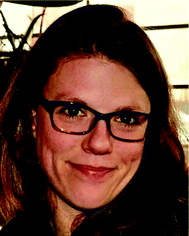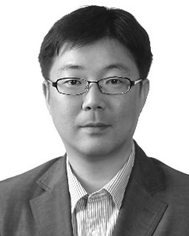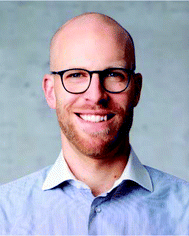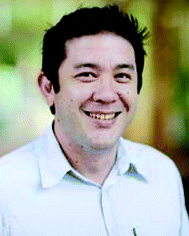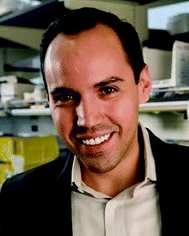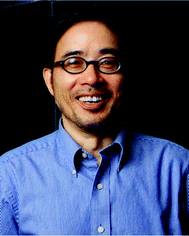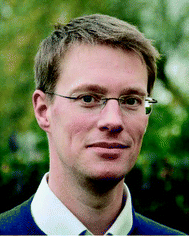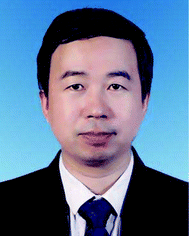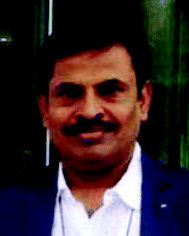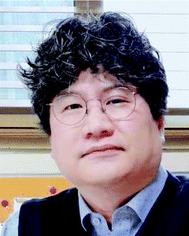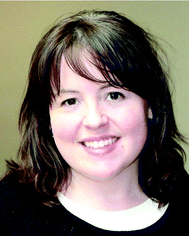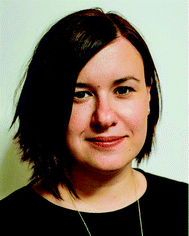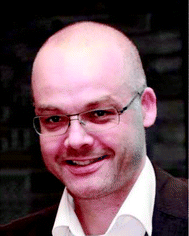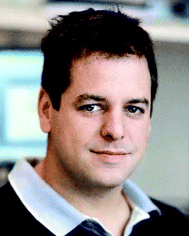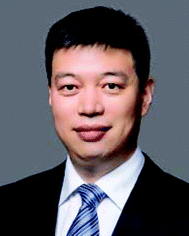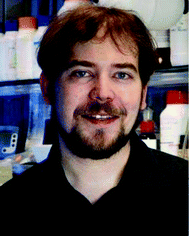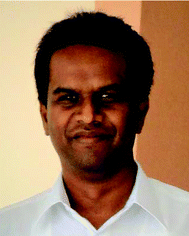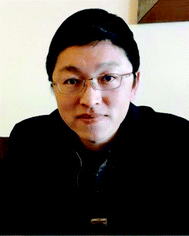DOI:
10.1039/C9PY90078K
(Editorial)
Polym. Chem., 2019,
10, 2896-2905
Pioneering investigators 2019
Polymer Chemistry is proud to present this second edition themed issue, celebrating the work of mid-career investigators who have established themselves in the field of polymer chemistry. Many of the researchers whose work is included in this Pioneering Investigators issue have previously been recognized as “emerging investigators” in the field in a past issue of Polymer Chemistry (http://bit.ly/2011Emerging, http://bit.ly/2015Emerging, http://bit.ly/2018Emerging).
This special issue includes 4 reviews and 29 original research manuscripts, including authors from 12 different countries and 31 different institutions. This special issue of Polymer Chemistry showcases leading research directions in relevant current areas of polymer science and demonstrates the enabling character of current polymer research at the interface with the biological sciences, surface science, photophysics and supramolecular chemistry. The creative and innovative research advancements reported here highlight the widespread impact of polymer chemistry research: from new polymerization techniques (e.g. DOI: 10.1039/C8PY01417E and DOI: 10.1039/C8PY01556B), to the tailored release of bioactive small molecules (e.g. DOI: 10.1039/C9PY00354A, DOI: 10.1039/C8PY01539B and DOI: 10.1039/C9PY00157C), to fundamental understanding of how chemical structure dictates self-assembly and bulk properties (e.g. DOI: 10.1039/C8PY01463A, DOI: 10.1039/C9PY00162J and DOI: 10.1039/C9PY00250B). We celebrate and praise the continued and ongoing contributions of the authors assembled in this volume to the field of polymer chemistry and thank them for their contributions to this special issue. We hope you enjoy reading the pioneering contributions of this Polymer Chemistry special issue!
Reviews:
• Functional protein materials: beyond elastomeric and structural proteins
• Polymer brush interfaces for protein biosensing prepared by surface-initiated controlled radical polymerization
• Recent advances in colloidal nanocomposite design via heterogeneous polymerization techniques
• Layer-by-layer assembly nanofilms to control cell functions
Communications:
• Improved malleability of miniemulsion-based vitrimers through in situ generation of carboxylate surfactants
• Ring-opening metathesis polymerization-induced self-assembly (ROMPISA) of a cisplatin analogue for high drug-loaded nanoparticles
• Self-amplified depolymerization of oligo(thiourethanes) for the release of COS/H2S
• Site-specific conjugation of antifreeze proteins onto polymer-stabilized nanoparticles
• Integration of metal-free ring-opening metathesis polymerization and organocatalyzed ring-opening polymerization through a bifunctional initiator
• A fluorescent pillarene coordination polymer
Articles
• Cooperative supramolecular polymerization of phosphorescent alkynyl-gold(I)-isocyanide complexes
• Tuning photosensitized singlet oxygen production from microgels synthesized by polymerization in aqueous dispersed media
• Structure and luminescence properties of supramolecular polymers of amphiphilic aromatic thioether–peptide conjugates in water
• Topochemical polymerization of hierarchically ordered diacetylene monomers within the block copolymer domains
• Shape modulation of squaramide-based supramolecular polymer nanoparticles
• Spatial control of the topography of photo-sensitive block copolymer thin films
• Self-assembly of oppositely charged polyelectrolyte block copolymers containing short thermoresponsive blocks
• Ferulic acid-based reactive core–shell latex by seeded emulsion polymerization
• Transformation of polyethylene into a vitrimer by nitroxide radical coupling of a bis-dioxaborolane
• Selective or living organopolymerization of a six-five bicyclic lactone to produce fully recyclable polyesters
• Transition metal-free thiol–yne click polymerization toward Z-stereoregular poly(vinylene sulfide)s
• The effect of chain architecture on the phase behavior of A4B4 miktoarm block copolymers
• Design and synthesis of a dual imageable theranostic platinum prodrug for efficient cancer therapy
• Precision design of vinyl amine and vinyl alcohol-based copolymers via cobalt-mediated radical polymerization
• Understanding the ring-opening polymerisation of dioxolanones
• Metal–organic insertion light initiated radical (MILRad) polymerization: photo-initiated radical polymerization of vinyl polar monomers with various palladium diimine catalysts
• Synthesis and crystallization behavior of regioregular-block-regiorandom poly(3-hexylthiophene) copolymers
• Evolution of diverse higher-order membrane structures of block copolymer vesicles
• Polyampholytic graft copolymers based on polydehydroalanine (PDha) – synthesis, solution behavior and application as dispersants for carbon nanotubes
• Hierarchical patterns with sub-20 nm pattern fidelity via block copolymer self-assembly and soft nanotransfer printing
• Surface modification of self-assembled isoporous polymer membranes for pressure-dependent high-resolution separation
• Mechanically robust photodegradable gelatin hydrogels for 3D cell culture and in situ mechanical modification
Holger Frey, Polymer Chemistry Associate Editor
Emily Pentzer, Polymer Chemistry Associate Editor
Biographies of contributors
Joona Bang received his B.S. degree in Chemical Engineering from Seoul National University in 1999. He received his Ph.D. degree from the University of Minnesota in 2004 on block copolymer physics. Then, he worked as a postdoctoral fellow at the University of California, Santa Barbara. Since 2006, he has been at Korea University as a Professor. His research interests focus on the synthesis and characterization of well-defined functional copolymers having non-linear architectures, such as stars and bottlebrushes, using living free radical polymerization, and surface modification of quantum dots for enhanced stability and improved performance in a variety of light emitting applications.
Pol Besenius was born in Luxembourg in 1981 and studied chemistry at the Vienna University of Technology in Austria, and at the University of Strathclyde in Glasgow, Scotland. He received his PhD from the same institution in 2008, under the supervision of Prof. Peter Cormack and Prof. David C. Sherrington FRS, in collaboration with Prof. Sijbren Otto and Prof. Jeremy K. M. Sanders FRS at the University of Cambridge. As a Marie-Curie Fellow, Pol undertook postdoctoral studies at the Eindhoven University of Technology with Dr Anja Palmans and Prof. E. W. “Bert” Meijer. In 2011, Pol moved to the University of Münster to set up an independent research group at the Organic Chemistry Institute, supported by a Liebig Fellowship. He was also elected as young fellow to the North Rhine-Westphalian Academy of Sciences and Arts. In 2015, he took up a Professorship at the Institute of Organic Chemistry at the University of Mainz. His research interests include macromolecular chemistry, self-assembly in water and on surfaces, and responsive supramolecular materials.
Idriss Blakey graduated from the Queensland University of Technology, Australia, in 2001 with a PhD in chemistry under the supervision of Prof. Graeme George. He worked as a research scientist at an Australian start-up company, Polymerat (Now Anteo Technologies), before taking a postdoctoral role at the University of Queensland (UQ) in 2003. While at the UQ, he has been awarded a Queensland Government Smart State Fellowship, an Australian Research Council Future Fellowship and a UQ Vice Chancellor’s Research and Teaching Fellowship. His research interests include the synthesis of polymers and understanding how their interfacial and physical properties influence performance in applications such as photolithography, biomedical imaging and self-assembly.
Andrew J. Boydston began studying chemistry as an undergraduate at the University of Oregon under the guidance of Professor Michael M. Haley. His research focused on the synthesis and study of dehydrobenzoannulenes. After completing BS and MS degrees, he began doctoral research at the University of Texas at Austin. While being co-advised by Professor Christopher W. Bielawski and Professor C. Grant Willson, Andrew completed his thesis research focused on the synthesis and applications of annulated bis(imidazolium) chromophores in 2007. He then took an NIH postdoctoral position at the California Institute of Technology under the mentorship of Professor Robert H. Grubbs. There, he developed new catalysts and methods for the synthesis of cyclic polymers. He returned to the Pacific Northwest as an Assistant Professor of Chemistry at the University of Washington in 2010 and was promoted to Associate Professor with tenure in 2016. In 2018, he moved to the University of Wisconsin as the Yamamoto Family Professor of Chemistry, where he also holds affiliate appointments in the Department of Chemical and Biological Engineering and Department of Materials Science and Engineering. His research group currently focuses on developments in the areas of polymer synthesis, mechanochemical transduction, and additive manufacturing (3D printing).
Sylvain Caillol was born in 1974 in Sète, France. He received his M.Sc. degree in Chemistry from the Engineering School of Chemistry of Montpellier. Then, he received his PhD degree in 2001 from the University of Bordeaux. Subsequently, he joined the company Rhodia. Later, after being promoted to Department Manager, he headed the Polymer Research Department in the Research Center of Aubervilliers. In 2007 he joined the CNRS at the Institute Charles Gerhardt of the University of Montpellier where he started a new research topic dedicated to green chemistry and speciality polymers. He is a co-author of more than 150 articles, patents and book chapters and is a member of the Editorial Boards of
European Polymer Journal and
Green Materials. He is Chairman of the “Oleochemistry, Molecule and Polymer Science” division of the European Federation of Lipids. He won the Innovative Techniques for Environment award in 2010 and the Green Materials Prize in 2018.
Luis M. Campos is an Associate Professor in the Department of Chemistry at Columbia University. He was born in Guadalajara, Mexico, and moved at the age of 11 to Los Angeles, California. He received a B.Sc. degree in Chemistry from CSU Dominguez Hills in 2001, and a Ph.D. from the Department of Chemistry & Biochemistry at UCLA in 2006 working under the supervision of M. A. Garcia-Garibay and K. N. Houk. At UCLA, he was awarded the NSF Predoctoral Fellowship, the Paul & Daisy Soros Fellowship, and the Saul & Silvia Winstein Award for his graduate research in solid-state photochemistry. Switching to materials chemistry, he went to UCSB as a UC President's Postdoctoral Fellow to work under the supervision of C. J. Hawker at the Materials Research Laboratory. At Columbia, his group's research interests lie in polymer chemistry, self-assembly, and organic electronic materials. To date, he has co-authored over 80 articles and 12 patents; and he has received various awards, including the ACS Arthur C. Cope Scholar Award, ONR Young Investigator Award, NSF CAREER Award, 3 M Non-Tenured Faculty Award, I-APS Young Faculty Award, the
Journal of Physical Organic Chemistry Award for Early Excellence, and the Polymers Young Investigator Award. In addition to these research accolades, Luis has been recognized for his pedagogical contributions by the Cottrell Scholar Award, Columbia University Presidential Teaching Award, and the Camille Dreyfus Teacher-Scholar Award.
Eugene Y.-X. Chen came to the United States for graduate studies from China in 1991 and received his Ph.D. degree from the University of Massachusetts, Amherst, in 1995, under the direction of late Professors James Chien and Marvin Rausch. After a postdoctoral stint at Northwestern University with Professor Tobin Marks, he joined The Dow Chemical Company in late 1997, where he was promoted from Sr. Research Chemist to Project Leader. He moved to Colorado State University in August 2000, where currently he is the John K. Stille Endowed Chair in Chemistry and the Millennial Professor of Polymer Science & Sustainability. His research interests encompass broadly the areas of polymer science, green and sustainable chemistry, and catalysis.
Antoine Debuigne is a permanent researcher of the National Fund for Scientific Research (FNRS) at the University of Liege, Belgium. He obtained his Ph.D. from the University of Liege in 2004 under the supervision of Prof. Robert Jérôme in the Center for Education and Research on Macromolecules (CERM). After graduation, he was a postdoctoral fellow in the group of Prof. Michael K. Georges at the University of Toronto and developed controlled radical polymerization methods under emulsion conditions. In 2006, he returned to Liege as a FNRS Postdoctoral Researcher and was promoted to a FNRS Research Associate in 2010 at the CERM. His research interests deal with macromolecular engineering essentially based on radical chemistry and emulsion polymerization.
Jianzhong Du received his PhD in chemistry in 2004 from the Institute of Chemistry, Chinese Academy of Sciences. Then, he worked as a research fellow at the University of Sheffield (2004–2008), the University of Cambridge and the University of Warwick (2008–2010). He was an Alexander von Humboldt fellow in Germany (2006). He was appointed as an ‘Eastern Scholar’ professor at Tongji University in Shanghai in 2009, and an adjunct Professor in Shanghai Tenth People's Hospital in 2015. Currently, he is Head of Department of Polymeric Materials, Tongji University. His research interests focus on the synthesis and application of smart and functional polymers and polymer vesicles. He has wide research interests in the interdisciplinary bridging between polymer science, nanomedicine, and materials science, such as controlled drug delivery, gene delivery, antibacterial materials, theranostic vesicles, the treatment of diabetes,
etc. Since 2003, he has published 65 papers as the corresponding author and 14 papers as the first author in
Chem. Soc. Rev.,
Prog. Polym. Sci.,
J. Am. Chem. Soc.,
Angew. Chem.,
Adv. Mater.,
Chem. Sci.,
ACS Nano,
Nano Lett.,
ACS Macro Lett.,
Polym. Chem.,
Macromolecules,
Biomacromolecules,
etc. He received the National Award for the Progress in the Science and Technology in 2016 and the Innovative Research Article Award for Basic Research in Polymer Science, Chinese Chemical Society in 2017. He is a fellow of the Royal Society of Chemistry (FRSC), a member of the
Biomacromolecules Editorial Advisory Board, and a Committee Member of the Division of Polymer Science, Chinese Chemical Society.
Nathan C. Gianneschi received his B.Sc (Hons) at the University of Adelaide, Australia, in 1999. In 2005 he completed his Ph.D at Northwestern University. Following a Dow Chemical postdoctoral fellowship at The Scripps Research Institute, in 2008 he began his independent career at the University of California, San Diego, where, until June 2017, he was a Teddy Traylor Scholar and a Professor of Chemistry & Biochemistry, NanoEngineering and Materials Science & Engineering. In July 2017, Nathan moved his research group to Northwestern University where he is currently a Jacob & Rosaline Cohn Professor of Chemistry, Materials Science & Engineering, and Biomedical Engineering. The Gianneschi group takes an interdisciplinary approach to nanomaterials research with a focus on multifunctional materials with interests that include biomedical applications, programmed interactions with biomolecules and cells, and basic research into nanoscale materials design, synthesis and characterization. For this work, he has been awarded the NIH Director's New Innovator Award, the NIH Director's Transformative Research Award and the White House's highest honor for young scientists and engineers with a Presidential Early Career Award for Scientists and Engineers. Nathan was awarded a Dreyfus Foundation Fellowship, and is a Kavli Fellow of the National Academy of Sciences, a Fellow of the Royal Society of Chemistry, and an Alfred P. Sloan Foundation Fellow.
Matthew I. Gibson holds a personal chair joint between the Department of Chemistry and the Medical School at the University of Warwick, UK. He obtained his undergraduate degree (2003) and PhD (2007) from the University of Durham, UK, working with Prof. Neil Cameron. After a postdoc at EPFL with Prof. Harm-Anton Klok, Matt was appointed at Warwick in 2009 and promoted to Full Professor in 2016. Matt holds an ERC starting grant and has won several awards including the MacroGroup Young researchers medal, the Dextra medal for Carbohydrate Science, the PAT young talent prize and the 2018
Macromolecules/
Biomacromolecules Young Investigator Prize. Matt's research addresses healthcare challenges including pathogen detection/neutralisation and new technologies for the storage and transport of biologics using a combination of polymer and glyco-science.
E. Bhoje Gowd was born in Kummara Nagepalli, Anantapur district, Andhra Pradesh. He received his B.Sc. and M.Sc. (Tech) in Polymer Science and Technology from Sri Krishnadevaraya University, Anantapur, Andhra Pradesh, and his Ph.D. from the University of Pune, Pune (work carried out at CSIR-National Chemical Laboratory under the guidance of Dr C. Ramesh). He worked as a post-doctoral fellow in Prof. Kohji Tashiro's group at the Toyota Technological Institute, Nagoya, Japan, and as an Alexander von Humboldt Fellow in Prof. Manfred Stamm's group at the Leibniz Institute of Polymer Research, Dresden, Germany. After a short stay at the Indian Institute of Science, Bangalore, as a Centenary post-doctoral fellow in Prof. S. Ramakrishnan's group, he joined the National Institute for Interdisciplinary Science and Technology (CSIR-NIIST), Thiruvananthapuram, as a DST-SERB Ramanujan Fellow. In 2011, he accepted the Senior Scientist position at CSIR-NIIST. He was awarded an IUSSTF research fellowship by Indo-US Science and Technology Forum in 2014 (Stony Brook University, Stony Brook, NY, USA) and the Raman Research Fellowship by CSIR, Government of India, in 2018 (National Tsing Hua University, Hsinchu, Taiwan). He was the recipient of the Materials Research Society of India (MRSI) Medal in 2016 and the Professor Kaushal Kishore Memorial Award of The Society for Polymer Science, India (SPSI) in 2018. He has authored more than 50 publications in peer-reviewed journals, edited a book and contributed to 4 book chapters. He has been invited to deliver talks at different forums from countries like Japan, USA, Italy, France, Germany, China, and Taiwan. His research interests are in the areas of polymer self-assembly, nanostructured materials, polymorphic phase transitions in semicrystalline polymers, polymer/inorganic hybrid nanocomposites, polymer–solvent complexes and biodegradable polymers.
Tijana Z. Grove received her Ph.D. degree from Iowa State University and postdoctoral training from Yale University. She established a nationally and internationally recognized research program at the intersection of chemistry, materials science, and biotechnology while a faculty member in the Virginia Tech Chemistry Department from 2011 to 2019. Currently, Tijana is the principal and founder of Zarkovic Grove Consulting, LLC, specializing in nanoscience, analytical, materials, and protein chemistry.
Eva Harth is a Professor of Chemistry at the University of Houston, Texas. She previously held positions as Assistant and Associate Professor at Vanderbilt University after conducting postdoctoral research at the IBM Almaden Research Center and a PhD from the MPI of Polymer Research in Mainz, Germany. Her research group is interested in new polymerization methodologies and novel materials for biomedical applications. The recent discovery of the Metal–organic Light Initiated Radical (MILRad) polymerization is a current focus and she explores the merging of insertion and radical polymerization techniques.
June Huh received his B.S. (1990) and M.S. (1992) degrees in Fiber and Polymer Science from Seoul National University and his Ph.D. (1998) in theoretical polymer physics from the University of Groningen, the Netherlands. He was a postdoctoral research fellow at the University of Pittsburgh and has worked at Seoul National University, Yonsei University, and Korea University as a research professor. Since 2018, he has been an Associate Professor of the Department of Chemical and Biological Engineering at Korea University. June has a speciality in the theoretical and computational modeling for various soft matter systems, such as polymer amphiphiles, proteins, and nanoparticles. His recent interest focuses on developing force fields for polymeric molecules in a coarse-grained description.
Marleen Kamperman is interested in the biologically-inspired synthesis of polymers and nanostructured surfaces with controlled adhesive and mechanical properties. She received her PhD in Materials Science & Engineering from Cornell University, Ithaca, NY, where she worked in the group of Prof. Wiesner on the development of ordered mesoporous high-temperature ceramics using block copolymers. From 2008 to 2010, she was a postdoctoral researcher in the Functional Surfaces group of Prof. Arzt at INM – Leibniz Institute for New Materials in Saarbrücken, Germany, where she worked on the development of bio-inspired responsive adhesive systems. She started her group ‘Bioinspired Functional Polymers’ at Wageningen University in the Physical Chemistry and Soft Matter department in September 2010. In 2015, she became a member of the Dutch Young Academy. In 2018 she was appointed Full Professor in Polymer Science at the University of Groningen. In the new research group that she established in Groningen she combines her experience in polymer science and material development with her interest in bio-inspiration. In 2018 she was awarded the Van Marumpenning from the Royal Netherlands Chemistry Society.
Andrea M. Kasko is a Professor in the Department of Bioengineering at UC Los Angeles. She received her B.S. in Chemistry from the University of Michigan in 1997, her M.S.E. in Macromolecular Science Engineering from Case Western Reserve University in 1999 (working with Professor Virgil Percec), and her PhD in Polymer Science at the University of Akron in 2004 (working with Professor Coleen Pugh). After two years of post-doctoral research sponsored by the Howard Hughes Medical Institute working with Professor Kristi Anseth at the University of Colorado, Boulder, Andrea joined the Bioengineering Department at UCLA in 2006. She currently serves as Vice Chair of the ACS Division of Polymer Chemistry. In recognition of the creative nature of her work, Andrea received the NIH Director's New Innovator Award. Andrea leads a multi-disciplinary research program focusing on the synthesis and characterization of novel polymeric materials for use in biomedical, drug delivery and tissue engineering applications, and biomimetic materials, including glycomimetics, lignin-derived materials, antimicrobial peptides, and their conjugates.
Roxanne E. Kieltyka received her BSc in Materials Chemistry from the University of Toronto (Toronto, Canada) in 2003. She then joined the group of Hanadi Sleiman at McGill University (Montreal, Canada) to work on the development of novel platinum-based complexes for the targeting of G-quadruplexes as an anti-cancer strategy. After receiving her PhD in 2009, she became a postdoctoral researcher in the group of Bert Meijer at the Eindhoven University of Technology (Eindhoven, the Netherlands) in the area of supramolecular materials. Since 2013, Roxanne is an Assistant Professor within the Supramolecular and Biomaterials Chemistry group at Leiden University (Leiden, the Netherlands). In 2018 she was named one of the Talented 12 by Chemical and Engineering News (C&EN). Her research focuses on the development of supramolecular biomaterials, ranging from studying their self-assembly to engineering applications in the healthcare area.
Bumjoon J. Kim has been a Professor in the Department of Chemical and Biomolecular Engineering at KAIST since 2008, where he is appointed as the KAIST Endowed Chair Professor. He completed his doctorate under the guidance of Prof. Edward Kramer at UCSB. Then, he worked with Prof. Jean Fréchet at UC Berkeley. His research interests include the development of block copolymer-based functional materials, including shape-tunable particles, colorimetric sensors, and the design of new electroactive polymers for all-polymer solar cells with high stability. He has guided 22 Ph.D. theses. He was appointed as the Ewon Assistant Professor at KAIST (2010–2013). Also, he received the KAIST Academic Excellence Award (2015) and the Shimgye Science Award (2017), and he was selected as the 2013 Young Scientist by the World Economic Forum (DAVOS Forum). He currently serves as an editorial advisory board member of
Macromolecules,
ACS Macro Letters,
Chemistry of Materials (ACS),
J. Mater. Chem. A (RSC) and
BMC Energy (Springer Nature).
Harm-Anton Klok studied chemical technology at the University of Twente (Enschede, the Netherlands) and received his Ph.D. from the University of Ulm (Germany, M. Möller). After postdoctoral research at the University of Twente (D. N. Reinhoudt) and the University of Illinois at Urbana–Champaign (USA, S. I. Stupp), he joined the Max Planck Institute for Polymer Research (Germany, K. Müllen). He was appointed to the faculty of EPFL in 2002. His research interests include polymer surface and interface science, polymer nanomedicine and polymer synthesis and functionalization.
John B. Matson received his undergraduate degree majoring in Chemistry and German in 2004 at Washington University in St Louis, carrying out undergraduate research with Professor Karen Wooley. He then moved to Caltech to pursue a PhD in the area of polymer synthesis with Professor Bob Grubbs. He graduated in 2009 and moved to Northwestern University, where he was an NIH-funded postdoctoral scholar working on peptide-based biomaterials with Professor Sam Stupp. In 2012 he began his independent career at Virginia Tech in the Department of Chemistry, where he was promoted to Associate Professor in 2018. He has received a number of awards, including the NSF CAREER Award and the Camille Dreyfus Teacher-Scholar Award. His group focuses on macromolecular and supramolecular chemistry with applications in biology, medicine, and sustainability.
Michiya Matsusaki received his Ph.D. degree in 2003 under the direction of Prof. Mitsuru Akashi from Kagoshima University. He started his academic career as a Postdoctoral fellow at Osaka University from 2003 to 2005. During this period, he was a visiting scientist at the Prof. Carl A. K. Borrebaeck laboratory in 2004 at Lund University. In 2006, he joined the Department of Applied Chemistry in the Graduate School of Engineering at Osaka University, Japan, as an Assistant Professor. He was promoted to Associate Professor in 2015. He is a JST-PRESTO researcher (concurrent position) from 2008 to 2011 and 2015 to present. He has received 16 awards. He has published 130 peer-reviewed papers (3500 citations,
h-index = 34). He is an Editorial Board Member of
PLoS ONE and
Scientific Reports. His research interests are functional polymers and biomaterials for biomedical and tissue engineering applications.
Damien Montarnal obtained his PhD from ESPCI ParisTech, France, in 2011, where he worked on supramolecular self-healing materials and initiated the concept of vitrimers under the supervision of L. Leibler and F. Tournilhac. He subsequently moved to UC Santa Barbara as a postdoctoral researcher with Craig Hawker, Edward Kramer and Glenn Fredrickson, working on block copolymer self-assembly. Damien is currently a CNRS research scientist in the Laboratory of Chemistry, Catalysis, Polymers and Processes at the University of Lyon. His research interests encompass all polymer materials in which supramolecular interactions or reversible chemistry can modulate the structure, dynamics or physical properties.
Renaud Nicolaÿ is Professor at ESPCI Paris where he is leading the research group “Chemistry and Macromolecular Design” within the laboratory “Molecular, Macromolecular Chemistry and Materials”. His research focuses on dynamic covalent chemistry and aims at developing new synthetic methodologies, as well as designing responsive formulations, vitrimers and structured materials. In this context, radical polymerization is a tool of choice to prepare functional polymers while controlling their topology. The introduction of dynamic chemical bonds in these systems gives access to materials that combine recyclability with superior mechanical, thermal and chemical resistance, as well as to materials and formulations whose connectivity and flow properties can be modulated by various stimuli.
Anjun Qin received his BS and PhD degrees from Shanxi University and the Institute of Chemistry, Chinese Academy of Sciences, in 1999 and 2004, respectively. He did his postdoctoral research at the Hong Kong University of Science & Technology and Zhejiang University in 2005–2008. He joined Zhejiang University as an Associate Professor in 2008 and moved to South China University of Technology with promotion to Full Professor in 2013. His current research interests include the development of new polymerizations based on triple-bond building blocks and constructions of organic/polymeric functional materials for high-tech applications.
Megan L. Robertson received her Ph.D. in Chemical Engineering from the University of California, Berkeley, and obtained experience as a Postdoctoral Research Associate at the University of Minnesota and Senior Scientist at Rohm and Haas, before joining the faculty of the Department of Chemical and Biomolecular Engineering at the University of Houston in the Fall of 2010. Megan's research interests include advanced polymer synthesis and characterization methods, nanostructured and microstructured polymers, self-assembly processes, and thermodynamics of multicomponent materials. Her group is currently working in five areas of emphasis: (1) sustainable and biodegradable polymers derived from renewable resources, (2) advanced materials for wind energy, (3) structure and dynamics of block copolymer micelles, (4) pH-responsive, antifouling polymer brushes, and (5) multicomponent and multiphase polymer blends.
Maud Save graduated with a M.Sc from the University of Bordeaux where she was introduced to polymer science in the research laboratory of Prof. Michel Fontanille. After completing her PhD in ring opening polymerization of cyclic esters with Prof. Alain Soum at the University of Bordeaux (2000), she worked as a Postdoctoral Researcher in the group of Steven P. Armes at Sussex University (UK). In 2002 she joined the group of Prof. Bernadette Charleux in Paris at the Université Pierre et Marie Curie as a CNRS Junior researcher where she developed research on controlled radical polymerizations and emulsion polymerizations. She participated in the pioneering research on the PISA (polymerization-induced self-assembly) process implemented in emulsion polymerizations. Then, in 2008, she moved to the IPREM laboratory at the University of Pau and Pays de l'Adour (France) and was promoted to full Senior Researcher by CNRS in 2015. Her research focuses on the synthesis and characterization of functional polymeric colloids and stimuli-responsive microgels using free or controlled radical polymerization in dispersed media. She also leads projects on polymers/emulsifiers from renewable resources.
Felix H. Schacher studied chemistry at the Universities of Bayreuth (Germany) and Lund (Sweden) and obtained his diploma in 2006. After his PhD under the supervision of Axel H. E. Müller in 2009, he joined the group of Ian Manners at the University of Bristol as a DAAD postdoctoral fellow. In 2010 he was appointed as a Junior Professor at the Friedrich-Schiller-Universität Jena and became a Full Professor at this institution in 2015. He has been awarded the Dr-Hermann-Schnell-Fellowship of the GDCh in 2013. His scientific interests include controlled/living polymerization techniques, block copolymers, polyelectrolytes, and polyampholytes – all in the context of using (directed) self-assembly processes for material design in the fields of membranes, hybrid materials, and biomedicine.
Michael P. Shaver, FRSC, is a Professor of Polymer Science in the School of Materials at the University of Manchester where he leads initiatives in sustainable polymers, plastics and materials for the School and for the Henry Royce Institute, the UK's national materials science centre. Following a PhD in his native Canada from the University of British Columbia and an NSERC Post-Doctoral Fellowship at Imperial College London, he began his independent research career at the University of Prince Edward Island before moving to Scotland in 2012 where he was a Chancellor's Fellow, Reader and Professor of Polymer Chemistry. He leads the Green Materials Laboratory on the development of sustainable materials, including new motifs for renewable, degradable and chemically recyclable materials. His work ranges from fundamental projects rooted in monomer design to working with industrial partners in plastic packaging, medical diagnostics and sustainable materials. He was the inaugural Editor-in-Chief of the international journal
Green Materials before his current role as Editor of the
European Polymer Journal. He has been recognised with >80 invited lectures, the MacroGroup Young Polymer Scientist award (2015), the Young Academy of Scotland (2014–2018), a Fellowship in the RSC (2018) and two Canada Foundation for Innovation Leadership Awards (2010, 2012).
Raja Shunmugam received his bachelor’s degree in 1994 and master’s degree in 1996 from V. O. C. College, Manonmaniam Sundaranar University, Tamil Nadu. He received his Ph.D. from the Indian Institute of Technology Madras under the guidance of Professor R. Dhamodharan. He then joined Professor Gregory N. Tew's laboratory in the Polymer Science and Engineering Department at the University of Massachusetts, Amherst, as a postdoctoral research associate from 2003 to August 2008. From September 2008 to 2013, he was an Assistant Professor in the Department of Chemical Sciences at the IISER-Kolkata. From January 2014 to September 2018, he was an Associate Professor in the Department of Chemical Sciences at the IISER-Kolkata. He was the Head of Department from February 2014 to March 2016. From October 2018 onwards, he is a full Professor in the Department of Chemical Sciences. He was a recipient of the prestigious Ramanujan Fellowship from the Department of Science and Technology, Government of India. He received a Joint Runner-Up award in the 6th National Award for Technology Innovation under the Polymeric Materials category, 20 January 2016, for his arsenic sensing work. He also received a Joint Winner Award in the 7th National Award for Technology Innovation under the Polymeric Materials category, 1 March 2017, for developing sensors for nerve agents. In 2018, again his group received a Joint Runner-Up award in the National Award for Technology Innovation under the Polymeric Materials category for developing new polymers for drug delivery applications.
Stuart C. Thickett is a Senior Lecturer in Chemistry at the University of Tasmania. He received his PhD from the University of Sydney in 2008 under the supervision of Professor Robert Gilbert in the area of emulsion polymerization kinetics and mechanism. He has held post-doctoral positions at the University of Toronto and the University of Sydney, working in the areas of polymer nanoparticle and polymer thin film design. In 2012 he joined the Centre for Advanced Macromolecular Design (CAMD) at UNSW as a Vice-Chancellor's Research Fellow, and was appointed Lecturer at the University of Tasmania in 2015. Stuart's research interests primarily focus on the physical chemistry of soft matter, namely polymer nanoparticles, colloids and interfaces, where he utilizes advanced polymerization techniques for the design of new materials. Stuart has published 49 journal articles in his career to date and presented his work at over 70 national and international conferences.
Ling-Shu Wan received his BS and PhD degrees from Nanjing Tech University and Zhejiang University, in 2002 and 2007, respectively. He joined Zhejiang University in 2007 and was promoted to Full Professor in 2015. He visited the University of Chicago in 2012–2013. His current research interests include isoporous separation membranes and polymer surface and interface science.
Ying-Wei Yang received his degrees (BSc in 2000 and PhD in 2005) from Nankai University, and gained postdoctoral training at Arizona State University (with John Chaput), UCLA (with Sir Fraser Stoddart), and UC Irvine (with Zhibin Guan) from 2005 to 2010. He became an Associate Professor of Chemistry at Jilin University in 2011, and was promoted to Full Professor in 2014. He has published over 140 peer-reviewed scientific papers. His research centers on organic supramolecular chemistry, multifunctional hybrid materials, and stimuli-responsive polymers. He was named one of the world's most Highly Cited Researchers for 2017 by Clarivate Analytics, and one of the 2017 Chinese Most Cited Researchers by Elsevier.
|
| This journal is © The Royal Society of Chemistry 2019 |
Click here to see how this site uses Cookies. View our privacy policy here.  a and
Holger
Frey
a and
Holger
Frey
 b
b


